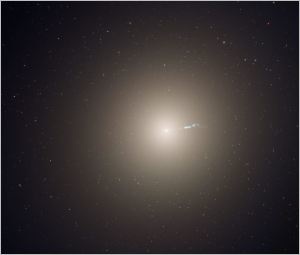
This artist’s impression depicts a rapidly rotating supermassive black hole surrounded by an accretion disc. This thin disc of rotating material consists of the leftovers of a Sun-like star which was ripped apart by the tidal forces of the black hole. Shocks in the colliding debris as well as heat generated in accretion led to a burst of light, resembling a supernova explosion. Credit: ESO, ESA/Hubble, M. Kornmesser/N. Bartmann

The giant elliptical galaxy, M-87 as imaged with the NASA/ESA Hubble Space Telescope. Clearly visible is the relativistic jet produced by the 6-billion solar mass black hole at the galaxy’s center. Image credit NASA/ESA, STSci; Aug 5, 2008
In an unprecedented observation of a class of objects that have been the center of much attention since they were first postulated by Karl Schwarzchild in 1916 using Einstein’s General Theory of Relativity, a world-wide collaboration of astronomers will release tomorrow, the first ever images of 2 super-massive black holes, Sagittarius-A at the center of our galaxy, the Milky Way and, a second at the center of the giant elliptical galaxy, Messier (M) 87 in Virgo.
The black hole at the center of M-87 has been known to exist for decades; as one of the largest known galaxies and the largest in the Virgo cluster of galaxies containing trillions of stars, M-87 was a clear first choice as a primary target for this study.
Since the scales and distances to the targets involved are tremendous, 25,000 light years for Sag-A at our galactic center and 54 million light years for M-87, an optical technique that leverages a property of light as a wave phenomenon to produce a telescope array (composed of many instruments linked as one) whose effective diameter is the greatest distance between them or, in this case, the diameter of the earth!
A basic rule of optics is that the resolution of a telescope increases linearly with size (diameter). Since the radius (the Schwarzchild radius, the distance inside of which nothing, not even light, can escape) of these black holes is not that large, conventional telescopes, not even the largest ground-based or orbiting telescope could resolve them at the distances involved, it was necessary to link multiple telescopes together in what is known as a VLBI (Very Long Baseline Interferometer).
As the first of its kind and known as the Event Horizon Telescope, an array of radio telescopes at disparate locations around the globe are linked together, effectively producing a virtual radio telescope whose diameter is the diameter of the earth! The EHT is not a single instrument but an array of radio telescope facilities linked together to observe the same target concurrently, not an easy task. Some of the facilities involved include the Atacama Large Millimeter/Submillimeter Array or ALMA facility in Chile, the South Pole Telescope, the IRAM 30 meter telescope in Spain, the Alfonso Serrano radio telescope in Mexico, the world´s largest single-dish steerable millimeter-wavelength telescope and the Greenland Telescope.
A total of six major press conferences will be held simultaneously around the globe in Brussels (Belgium, English), Santiago (Chile, Spanish), Shanghai (Mandarin), Taipei (Mandarin), Tokyo (Japan, Japanese), and Washington DC (USA, English). The European Commissioner for Research, Science and Innovation, Carlos Moedas will speak in Brussels, the President of the Academia Sinica, James Liao, will speak in Taipei, the ALMA Director Sean Dougherty and the ESO Director General Xavier Barcons will speak in Santiago, and the NSF Director France A. Córdova will speak in Washington DC.
A live press event will be sponsored by the US National Science Foundation tomorrow, April 10, 2019 and can be streamed live here

